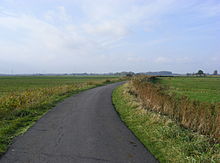Polder stairs

A polder staircase describes the stair-like elevations of the land from older to newer marshland .
Polder stairs are usually created with several dike measures one after the other. In the course of time, sea sediments are deposited in the salt marshes in front of the dykes and thus increase the natural seabed in the foreland of the dykes. This land reclamation through tipping is often supported by a system of groynes and parapets . If the land has grown strong enough, a new dike is built on the outside of the dike and the new marshland is completely drained. The newly diked land is called polder or regionally also Koog (Schleswig-Holstein) or Groden (Lower Saxony). Due to the drainage that now follows, the land settles in the newly diked polder. The rising sea level in front of the dike and the sagging of the drained former sea areas behind the dike therefore lead to an ever higher position of the newly diked polders with several dikes. This creates a so-called polder staircase.
The polder staircase effect posed great problems for people in draining the inland polders. The water must be pumped up for drainage. For this purpose, water mills were used in earlier times . Today these tasks are carried out by Sielen with powerful pumping stations .
literature
- A. Lax, Werner Haarnagel, Lower Saxony State Institute for Marsh and Wurten Research: Problems of coastal research in the southern North Sea area. Volume 26, 1999, ISBN 978-3-8959-8703-8 .
- Hansjörg Küster: History of the landscape in Central Europe. From the Ice Age to the Present, Verlag CH Beck, Munich 1995, ISBN 3406-45357-0 .
Individual evidence
- ↑ Sande Climate Path, page 22 (PDF; 1.5 MB), accessed on May 20, 2013
Web links
- The Eiderstedt peninsula (accessed November 7, 2019)
- The rise of the Holocene sea level south of the East Frisian island of Langeoog, southern North Sea (accessed November 7, 2019)
- Landscape framework plan update 2017 (accessed on November 7, 2019)